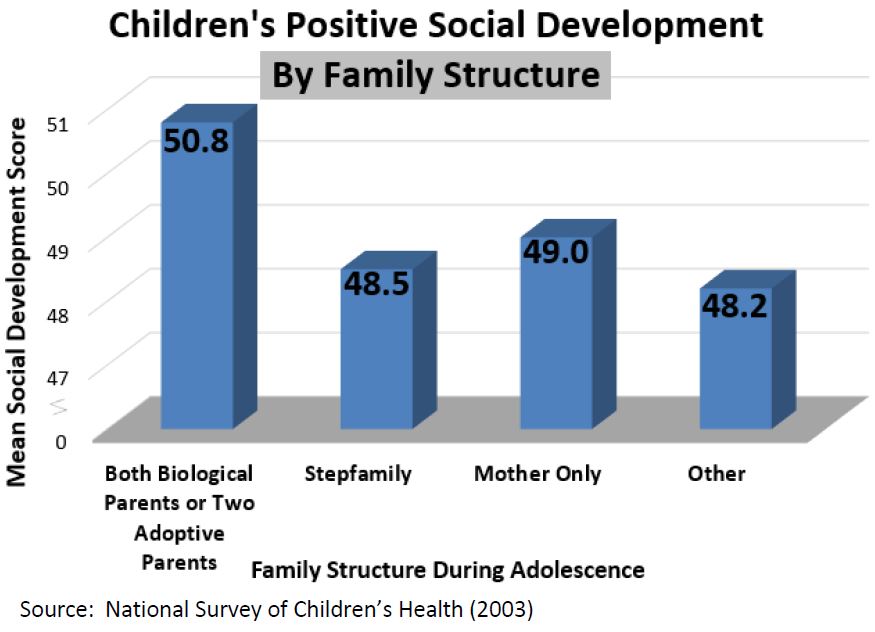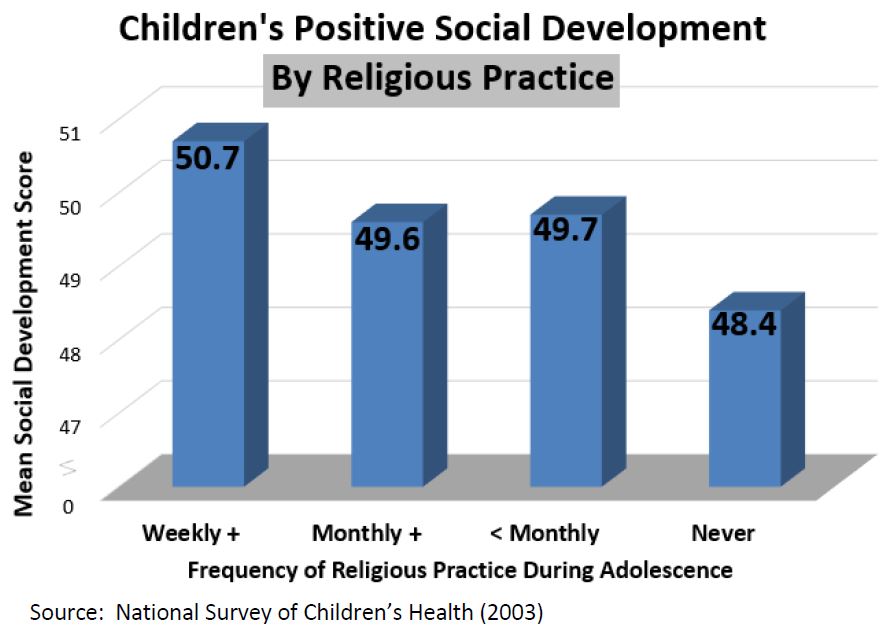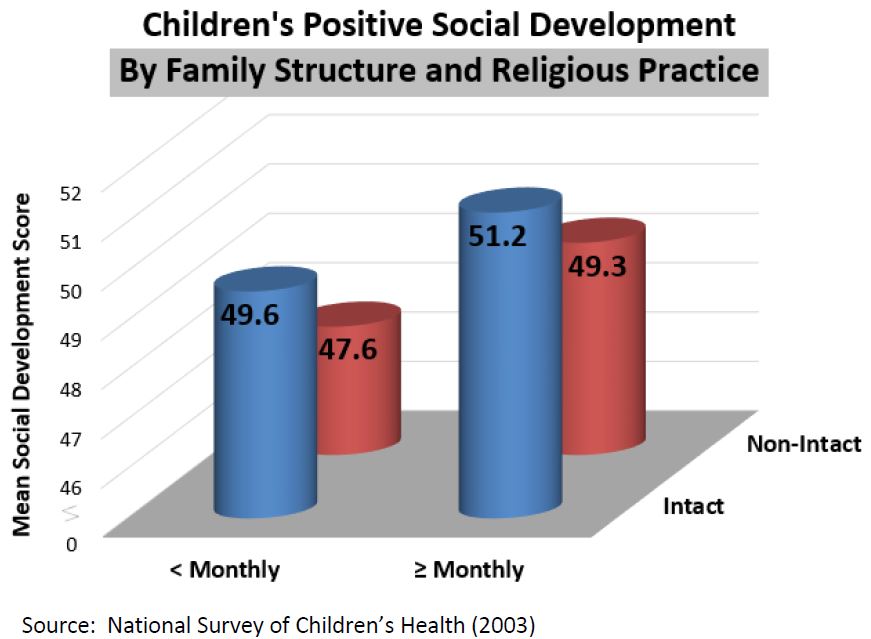Click Here to download “Children’s Social Development by Family Structure and Religious Practice”
Children’s Social Development by Family Structure and Religious Practice
Family Structure: Children who lived with both biological parents or two adoptive parents scored higher on the social development scale (50.8) than children who lived within other family configurations (48.2), such as with their father only or foster parents.[1] In between were those who lived in a stepfamily (48.5) and those who lived with single mothers (49.0).[2] Religious Practice: Children who attended religious services at least weekly scored higher on the social development scale (50.7) than children who never attended religious services (48.4). In between were children who worshipped one to three times a month (49.6) and children who attended religious services less than once a month (49.7).
Religious Practice: Children who attended religious services at least weekly scored higher on the social development scale (50.7) than children who never attended religious services (48.4). In between were children who worshipped one to three times a month (49.6) and children who attended religious services less than once a month (49.7).
 Family Structure and Religious Practice Combined: Children who worshipped frequently and lived with both biological parents or with two adoptive parents had a higher score (51.2) than those who worshipped less than monthly and lived in single-parent or reconstituted families (47.6). In between were those who lived in intact families and worshipped less than monthly (49.6) and those who lived in non-intact families who worshipped at least monthly (49.3). The data were taken from the National Survey of Children’s Health.
Family Structure and Religious Practice Combined: Children who worshipped frequently and lived with both biological parents or with two adoptive parents had a higher score (51.2) than those who worshipped less than monthly and lived in single-parent or reconstituted families (47.6). In between were those who lived in intact families and worshipped less than monthly (49.6) and those who lived in non-intact families who worshipped at least monthly (49.3). The data were taken from the National Survey of Children’s Health.
 Related Insights from Other Studies: Several other studies corroborate the direction of these findings. Jerry Trusty of Texas A&M University and Richard Watts of Baylor University reported that high school seniors who frequently participated in religious activities were more likely to have involved parents and less likely to exhibit delinquent behavior.[3]
John Bartkowski of Mississippi State University and colleagues also found that both parents’ frequent worship corresponded to several positive outcomes in their children, including greater social skills, greater interpersonal skills at school, protection “against internalizing problem behaviors,” protection against loneliness/sadness, and protection from overactive and impulsive behaviors in the home.[4] As the evidence shows, children who live with both parents in a religiously active family are more likely to develop positive social behavior.
[1] “Other family configurations” also include children living with grandparent or other relatives.
[2] Most of the parents in the “biological parent and a stepparent” category are married.
[3] Jerry Trusty and Richard E. Watts, “Relationship of High School Seniors’ Religious Perceptions and Behavior to Educational, Career, and Leisure Variables,” Counseling and Values, vol. 44 (1999): 30-40.
[4] John P. Bartkowski, et al., “Religion and Child Development: Evidence from the Early Childhood Longitudinal Study,” Social Science Research, vol. 37 (2008): 18-36.
]]>
Related Insights from Other Studies: Several other studies corroborate the direction of these findings. Jerry Trusty of Texas A&M University and Richard Watts of Baylor University reported that high school seniors who frequently participated in religious activities were more likely to have involved parents and less likely to exhibit delinquent behavior.[3]
John Bartkowski of Mississippi State University and colleagues also found that both parents’ frequent worship corresponded to several positive outcomes in their children, including greater social skills, greater interpersonal skills at school, protection “against internalizing problem behaviors,” protection against loneliness/sadness, and protection from overactive and impulsive behaviors in the home.[4] As the evidence shows, children who live with both parents in a religiously active family are more likely to develop positive social behavior.
[1] “Other family configurations” also include children living with grandparent or other relatives.
[2] Most of the parents in the “biological parent and a stepparent” category are married.
[3] Jerry Trusty and Richard E. Watts, “Relationship of High School Seniors’ Religious Perceptions and Behavior to Educational, Career, and Leisure Variables,” Counseling and Values, vol. 44 (1999): 30-40.
[4] John P. Bartkowski, et al., “Religion and Child Development: Evidence from the Early Childhood Longitudinal Study,” Social Science Research, vol. 37 (2008): 18-36.
]]>
